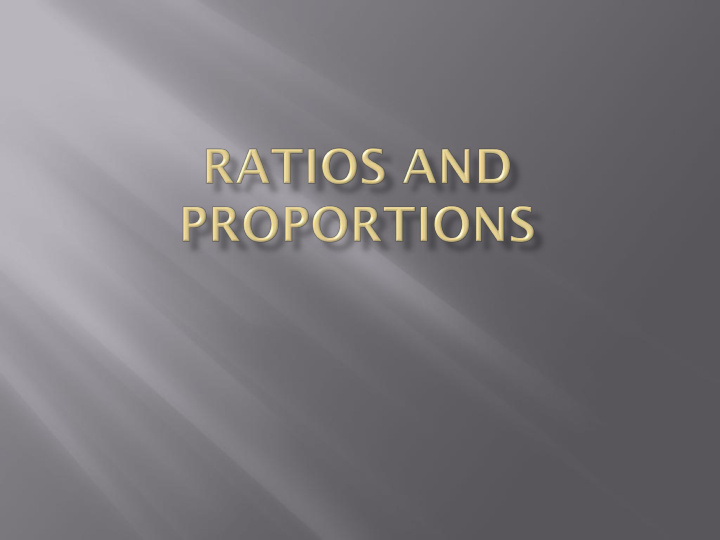



Ratios just are a way to specifically say how to things relate to each other. In a ratio the order is very important. To express a ratio, you just list the number of the first item, then the number of the second item.
So if there are 20 students and 1 teacher then: We can write ratio of students to teachers using a colon (20:1), a fraction (20/1) or just by writing “20 to 1”. We can write the ratio of teachers to students as 1:20, 1/20 or “1 to 20” Note the difference in the order of the words corresponds to the difference in the order of the numbers.
Since ratios can be written as fractions, ratios are often written in reduced form. Thus, 6:3 is usually written as 2:1 since the fraction 6/3 is the same as 2/1 Reduce (if possible) each ratio: 15:9 14:4 8:3
Since ratios can be written as fractions, ratios are often written in reduced form. Thus, 6:3 is usually written as 2:1 since the fraction 6/3 is the same as 2/1 Reduce (if possible) each ratio: 15:9 = 5:3 14:4 = 7:2 8:3 = 8:3 (no change)
For example, if the ratio of students to teachers is 20 to 1, then for every 20 students, there is one teacher. This means that if there are 100 students, there must be 5 teachers. Remember that we could have written the ratio of teachers to students as 1 to 20.
Ratios are used everywhere in the real world, as they can specify relationships that must always hold. One example is the United States flag: The United States has very specific guidelines set out for the use and display of the American flag. One of the rules regards the dimensions of the flag. The rule is that the ratio of the width of the flag to the height must be 19:10. Thus, for every 19 units wide the flag is, it must be 10 units tall. There are of course other ratios in the process: designating the size of the bars, and the placement and size of the stars, however, we will only concern ourselves with the overall size ratio of 19:10.
Does a flag which is 9.5” by 5” satisfy this requirement? What about a flag which is 3 feet wide and 2 feet tall?
Does a flag which is 9.5” by 5” satisfy this requirement? Yes! Remember the ratio was Width to Height = 19:10 9.5/5 = 1.9 = 19/10 What about a flag which is 3 feet wide and 2 feet tall? No! 3/2 = 1.5 ≠ 19/10
By specifying the ratio of our flag’s width to height, the government lets us make any sized flag that we want, while still preserving what it looks like. This is just a way to standardize the appearance of the flying flag. (Note that many uses of the flag by the general public to show patriotism do not adhere to this ratio.)
On the next few slides, there are 3 American flags with varying width to height ratios. For comparison, I have fixed the width of each flag at 4”. (Note the difference in their heights) Calculate the Width to Height ratio (to the nearest .01) for each flag, and then decide if it is the correct ratio.
4” wide by 2.8”
4” wide by 2.28”
4” wide by 2.1”
Two ratios are in proportion when they are equal. So, a proportion is just two ratios which have been set equal. An example of a proportion is 9.5 / 5 = 19 / 10. Usually, we use proportions to solve for a piece of missing information in a situation where we know what the ratio should be.
We know that the ratio of width to height of an American flag should be 19:10. Let’s say that I wanted to make a flag which was 25 feet wide, then I don’t know how tall to make it! So I will set up a proportion: Let H = the height of the flag I am making. For the flag I am making, the ratio of width to height is 25/H. The correct ratio is 19/10, so I will set the two equal.
To solve this, we use “cross - multiplication” Q: Why does cross-multiplication work? So, 25*10 = 19*H or 250 = 19H
This is an equation that we know how to solve! 250 = 19H Divide both sides by 19. H = 250/19 ≈ 13.2 What did this number represent?
Let’s say that I was hired to paint a correctly dimensioned American flag on the side of a wall which is 8 ft tall and really long. I need to know how wide to make the flag. Let W = the width of our flag. What is the ratio of width to height of our flag?
The ratio of width to height of our flag is: W/8 The ratio it should have is 19/10. So we set them equal. How do we solve this?
Cross-Multiply!! Thus, 10W = 152 How do we solve this? So W = _____
If you need more practice with this, here are some useful websites: http://www.bbc.co.uk/skillswise/numbers/wholenumbers /ratioandproportion/ratio/index.shtml http://math.rice.edu/~lanius/proportions/index.html http://www.purplemath.com/modules/ratio.htm http://www.math.com/school/subject1/lessons/S1U2L1GL .html http://www.algebrahelp.com/lessons/proportionbasics/ http://www.regentsprep.org/regents/math/proport/Lprop .htm http://www.mathleague.com/help/ratio/ratio.htm
http://www.quia.com/rr/35675.html?AP_ran d=1409502491 Play the game at this link. See if you can make it to $1,000,000!
Recommend
More recommend